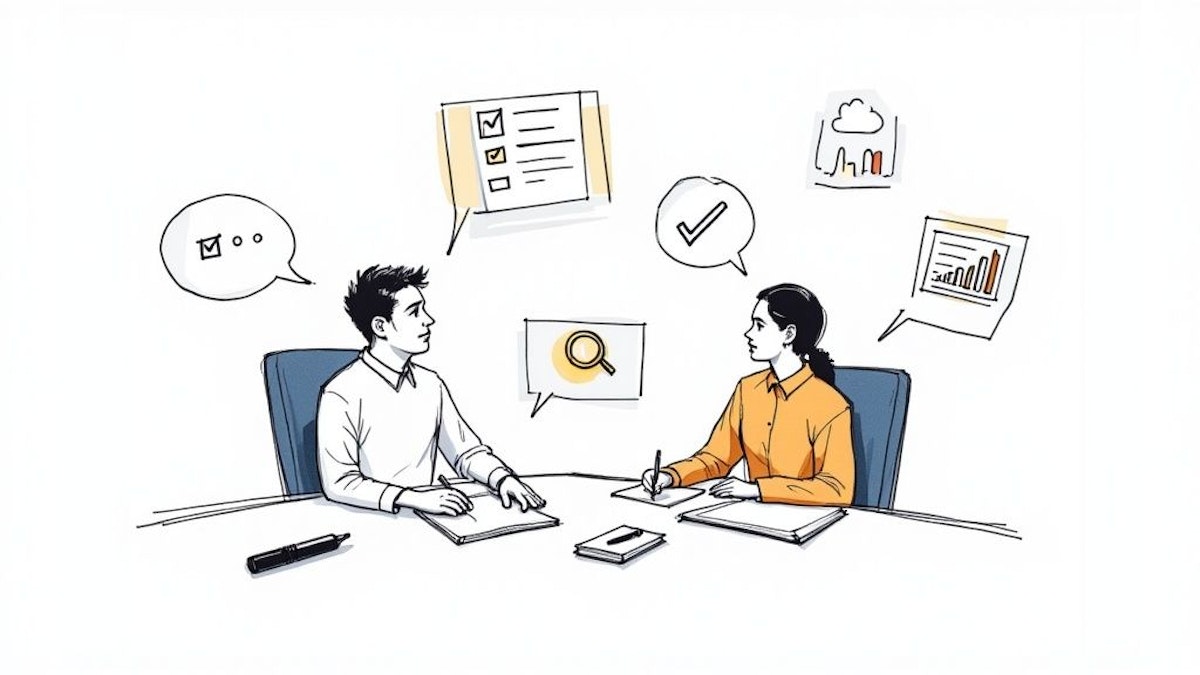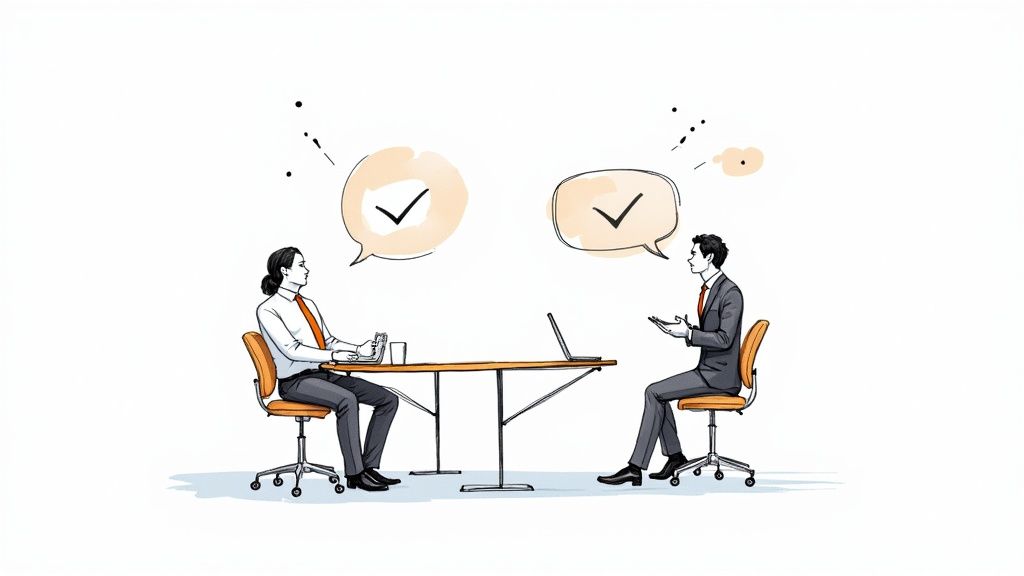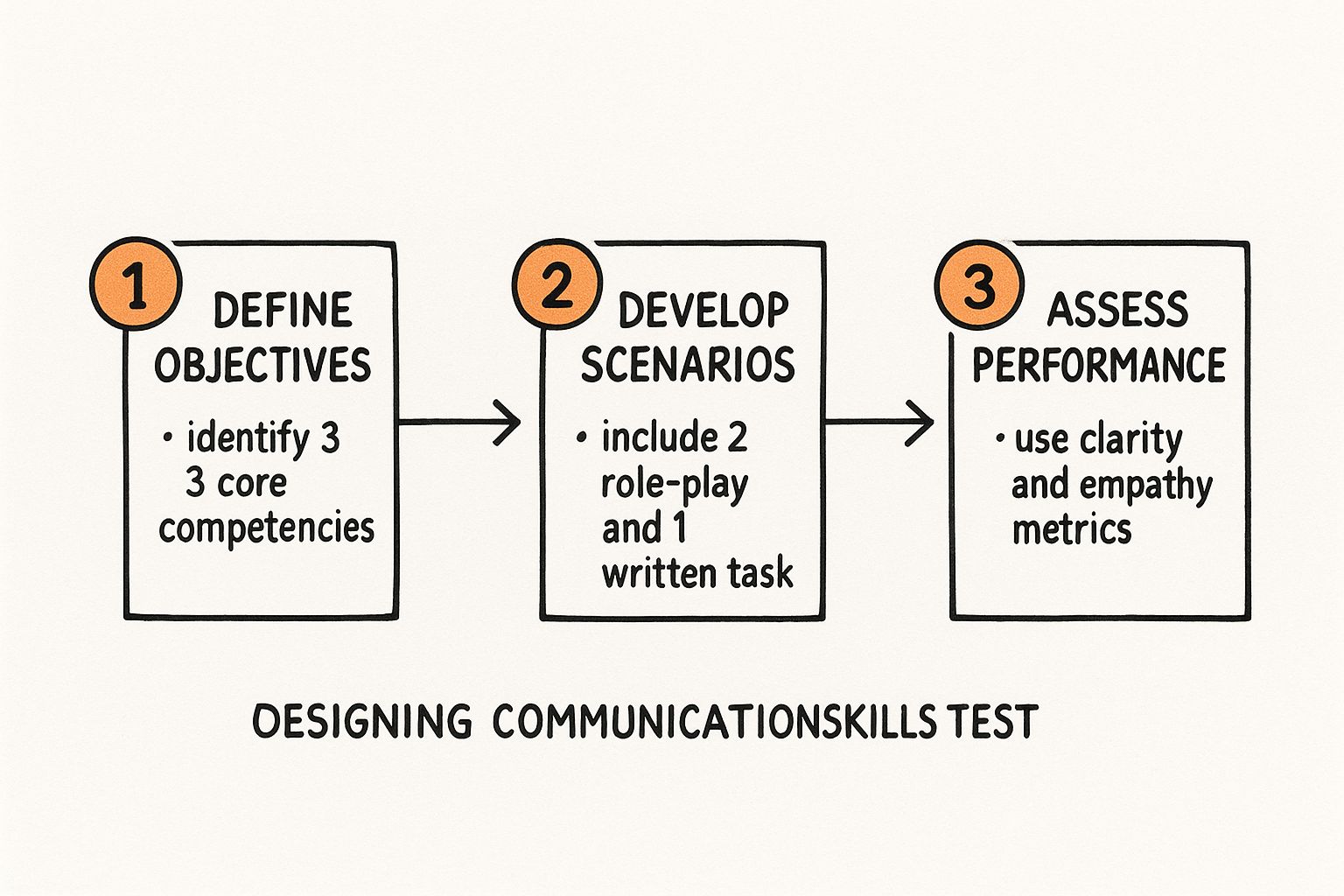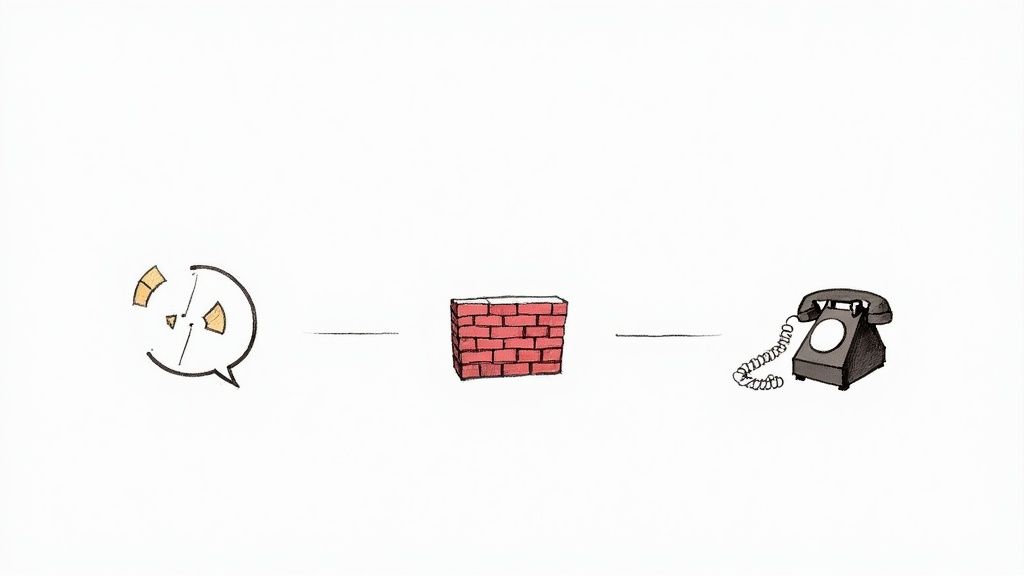A Guide to Testing Communication Skills in Hiring

When it comes to testing communication skills, you have to move past "interview chemistry" and gut feelings. A truly effective process relies on structured, data-backed assessments that show you how a candidate actually conveys ideas, listens, and works with others. This isn't just about ticking a box; it's about gathering real evidence of their potential to succeed in the role and add to your company culture.
Why Gut Feelings Are Not Enough for Hiring

We've all been there—a candidate walks in, they're charismatic, easy to talk to, and you just get a "good feeling." But relying solely on that feeling is a massive gamble. Charm doesn't guarantee they can break down a complex project for a client, navigate a tense team discussion, or collaborate effectively when a deadline is looming.
The consequences of getting this wrong are very real. A study by the Society for Human Resource Management (SHRM) found that communication problems are a significant factor in workplace conflicts, with 80% of employees reporting stress due to ineffective company communication. This isn't just about hurt feelings or office drama; it has a direct, measurable impact on the business.
The True Cost of Poor Communication
When communication unravels, everything else follows. Projects go off the rails, deadlines get blown, and morale takes a nosedive. Teams fall out of sync, leading to redundant work and wasted resources that quietly bleed the company dry. These issues eventually spill over, affecting client relationships and chipping away at your bottom line.
This is where a systematic approach to testing communication skills completely changes the game. It moves the conversation from vague impressions to concrete evidence, making your entire hiring process fairer and far more effective.
By standardizing how you measure this critical skill, you’re not just hiring for today—you're building a more resilient, collaborative, and high-performing workforce for the future. You're ensuring every new team member is a strong communicator from their very first day.
From Subjective to Structured Evaluation
Structured assessments create a clear, consistent benchmark for what "good communication" actually looks like at your company. Instead of leaving it up to an interviewer's personal interpretation, you're evaluating every single candidate against the same well-defined criteria. This data-driven approach helps you pinpoint people who have both the technical chops for the job and the interpersonal skills to thrive.
A structured process is also a powerful tool for building a more equitable hiring environment. It ensures everyone is measured by the same yardstick, which is a key part of an evidence-based approach to reducing hiring bias. When you focus on demonstrated skills over personal affinity, you naturally open the door to a more diverse and capable talent pool.
Ultimately, making data-backed decisions is about managing risk. A bad hire is incredibly expensive, not just in recruitment costs but in the cultural toll it takes on a team. Investing in a solid process for testing communication skills is one of the smartest moves you can make to build a team that's set up for long-term success. It's how you create a workplace where clarity and collaboration aren't just buzzwords—they're the standard.
Designing Assessments That Predict Real-World Success
Generic, off-the-shelf tests rarely tell you what you really need to know. When it comes to communication skills, context is everything. An assessment for a top-tier sales leader needs to look completely different from one for a customer support specialist—their daily challenges just aren't the same.
The real magic happens when you create scenarios that mirror what a new hire will actually face day-to-day. This is how you move beyond simple Q&As and build an assessment that’s a powerful predictor of on-the-job performance.
Pinpoint Core Competencies First
Before you even think about writing a question, you have to get crystal clear on the specific communication competencies that are vital for the role. It’s not enough to just put "strong communication skills" on the job description. You need to break that down into real, tangible behaviors.
What does a win actually look like in this position?
- For a Project Manager: Is it nailing concise status updates? Is it de-escalating client concerns before they blow up? Or is it mediating disagreements between team members to keep things moving?
- For a Software Developer: Maybe it’s the ability to document complex code so anyone can understand it. Or it could be explaining technical decisions to non-tech stakeholders without making their eyes glaze over.
Zeroing in on these distinct skills is what makes your assessment relevant and fair. Grounding your tests in well-defined job requirements is also the key to ensuring their validity and reliability. You can dive deeper into building assessments that hold up to scrutiny by exploring best practices for validity in assessments.
Build Scenarios That Reflect Reality
Once you know what you’re measuring, you can cook up realistic scenarios to see those skills in action. I’ve found that Situational Judgment Tests (SJTs) and role-playing exercises are incredibly effective for this.
An SJT, for instance, can present a candidate with a common workplace dilemma and ask them to choose the best response. You could create a scenario where a customer is justifiably frustrated with a product bug and have them draft an email response. This tests their written communication, empathy, and problem-solving all at once.
Role-playing takes it a step further. You might simulate a difficult conversation with an underperforming team member or a tough negotiation with a key vendor. This is perfect for observing active listening, conflict resolution, and adaptability in the moment.
Global employers consistently rank communication as one of the most critical skills they look for. A 2024 report from the National Association of Colleges and Employers (NACE) found that 82.5% of employers seek candidates with strong communication skills.
The data shows why tailored, role-specific assessments are so crucial. The same NACE report identified specific communication skills that matter most to employers, including verbal communication, active listening, and the ability to communicate with individuals inside and outside the organization.
This simple framework shows how to structure your design process.

The takeaway here is that a structured approach—defining what you need, building a relevant test, and using clear metrics—is what separates a guessing game from a genuinely predictive assessment.
Measuring What Matters Most
Finally, your assessment is only as good as its scoring rubric. Without a clear and consistent way to score responses, you risk falling back on the same subjective "gut feelings" you were trying to avoid in the first place.
Your rubric should clearly define what excellent, good, and poor performance looks like for each competency you're testing.
- Clarity: Is the message easy to understand? Did they avoid jargon?
- Empathy: Does the candidate actually acknowledge the other person's perspective?
- Conciseness: Do they get straight to the point?
- Adaptability: Can they shift their style based on who they're talking to?
To really nail this, it helps to understand the fundamentals of effective interaction; you can find great resources on how to improve communication to build out your rubrics. By combining realistic scenarios with objective scoring, you create a powerful system for finding people who won’t just fit in, but truly excel.
Choosing the Right Assessment Technology
The right tech can completely change how you assess communication skills, taking you from subjective, gut-feel decisions to an efficient, data-driven process. Modern tools are a world away from simple multiple-choice quizzes. We're talking about interactive scenarios and AI-powered video analysis that give you a genuinely deep look into a candidate's abilities.
But picking a platform isn't just a feature-for-feature comparison. It’s about finding a tool that aligns with your hiring culture and, just as importantly, enhances the candidate experience. A clunky, impersonal assessment can easily turn off top talent before they even get a chance to speak with a hiring manager.
Just look at how a modern dashboard can present clear, actionable data.

When you can visualize candidate data like this, your hiring managers can quickly compare applicants, spot key strengths, and identify potential red flags without getting bogged down in endless spreadsheets.
Key Features That Actually Matter
When you start digging into different platforms, it’s easy to get sidetracked by flashy features that don't actually move the needle. To stay focused, you need to prioritize the tools that will genuinely improve the quality and efficiency of your hiring.
Here are a few non-negotiables I always look for:
- Customizable Scoring Rubrics: Consistency is king. Any platform worth its salt will let you build and apply detailed, role-specific rubrics. This ensures every single candidate is measured against the same objective standards.
- Automated Reporting and Analytics: Your team doesn't have time to manually crunch numbers. Look for tools that generate instant, easy-to-read reports and offer a central dashboard for spotting trends across your entire candidate pool.
- ATS Integration: A smooth connection to your Applicant Tracking System is absolutely critical. It eliminates manual data entry, cuts down on errors, and keeps all your candidate information in one accessible place.
The goal is to find a solution that simplifies your workflow, not complicates it. The best technology should feel like a natural extension of your hiring team, giving them better data to make smarter decisions.
This shift toward structured, evidence-based hiring is behind some serious market growth. According to research from Allied Market Research, the global pre-employment testing software market was valued at $2.6 billion in 2022 and is projected to reach $6.3 billion by 2032. This isn't just a trend; it's a fundamental change in how companies find and hire talent.
A Practical Checklist for Evaluating Platforms
With so many options out there, it’s vital to have a clear framework for evaluation. Before you sign on the dotted line, use this checklist to guide your thinking. Think of it as a scorecard to make sure you're choosing a partner, not just a product.
Here’s what to look for when you're testing communication skills assessment tech:
- The Candidate Experience: Is the interface intuitive? Engaging? Does it make your company look good? A positive, professional experience is non-negotiable for attracting top-tier talent.
- Assessment Quality: Does the platform offer a variety of scientifically-validated assessments, like situational judgment tests or video-based role-plays? You want tools that measure behavior, not just what someone knows.
- Objective, Data-Driven Insights: Can the tool deliver unbiased, quantifiable data? AI-powered analysis is great, but it needs to be backed by transparent scoring logic so you know how it reached its conclusions.
- Scalability and Support: Will this platform grow with your company? You need to check for flexible pricing tiers, enterprise-level features, and customer support that’s actually responsive when you need them.
If you’re looking to get more creative, some companies are exploring technologies like chat API solutions for hiring platforms to simulate real-time conversations and interactions.
Ultimately, your choice has to align with your specific hiring needs. A great next step is to explore a curated list of communication assessment tools to see how different platforms measure up against these criteria. Finding the right tech partner is a foundational step in building a truly world-class hiring process.
Placing Your Assessment in the Hiring Funnel
Knowing what to assess is only half the battle. The real strategic question is when to ask candidates to complete a communication skills assessment. This isn't just a matter of logistics; it's a decision that directly impacts your candidate experience, the quality of your data, and how efficiently you can move people through your hiring process.
There's a delicate balance to strike. You want to gather valuable insights without creating a roadblock that causes great candidates to walk away. The sweet spot depends entirely on the role and the volume of applicants you're dealing with.
The Early-Stage Filter: Taming High-Volume Applications
If you're hiring for a role that attracts hundreds of applicants, like customer service or sales development, using a communication assessment right after the initial application can be a lifesaver. It acts as a powerful, objective filter.
Think about it. Instead of your team spending hours on screening calls with candidates who can't string a professional email together, the assessment does the heavy lifting. It quickly surfaces those who meet your baseline for effective communication.
- The upside? A massive reduction in manual screening time. You're ensuring that every candidate who makes it to a human conversation has already demonstrated foundational communication skills.
- The potential downside? Some top-tier talent might be put off by an upfront test before they've even spoken to someone. It can feel like jumping through hoops.
The trick to avoiding that drop-off is transparency. Be upfront about the assessment in your job posting and application confirmation. Frame it as their first chance to show off their skills in a way a static resume never could.
The Late-Stage Differentiator: Making the Final Call
The other school of thought is to save the assessment for later in the game—after the first or second interview, but before the final offer. At this point, you're not just screening for basic competency. You're trying to make a tough call between a few fantastic finalists.
This approach is perfect for senior-level or highly specialized positions. You can get incredibly specific with your scenarios. For example, you could ask a marketing director candidate to draft a delicate crisis response email, or have a prospective product manager record a brief video pitching a new feature to stakeholders.
This is where an assessment really shines. It gives you concrete data to back up your team's gut feelings. When you're stuck between two great candidates, seeing how each one actually performs on a job-relevant task can be the tiebreaker that saves you from a costly mis-hire.
How to Talk to Candidates About the Assessment
No matter when you decide to deploy the test, how you communicate it is everything. A surprise assessment feels like a pop quiz and can create unnecessary stress, which reflects poorly on your company. A thoughtful, well-explained process, on the other hand, shows you value fairness and respect the candidate's time.
Here's what you need to tell them, loud and clear:
- Explain the "Why": Give them a simple, one-sentence explanation. "This short assessment helps us see your communication skills in action, which is a key part of the [Role Name] role."
- Set Clear Expectations: Tell them exactly how long it will take (15-20 minutes, for example) and what to expect (e.g., "You'll respond to three written scenarios and record one short video response.").
- Offer a Lifeline: Make sure they know who to contact if they run into a technical snag. A simple "Reply to this email if you have any questions" goes a long way.
This small effort builds trust and significantly improves completion rates. By being strategic about placement and transparent in your communication, you can make assessments a truly powerful part of your hiring strategy. For more ideas on how different types of evaluations can fit into your process, check out this guide to pre-employment assessment tools.
From Scores to Stories: Making Sense of the Data

The assessments are done, the scores are in, and you’re looking at a dashboard full of numbers. Now the real work starts: turning that raw data into a clear story about each candidate. When you're testing communication skills, simply sorting people into "pass" or "fail" piles just doesn't cut it. Your goal is to find the nuances that separate a good communicator from a truly great one.
Think of a score as just the beginning of the conversation. It tells you what happened, but the story behind it reveals the why and the how. Did someone nail written clarity but sound less confident on video? Or maybe they were fantastic listeners but struggled to build a persuasive argument. These are the details that give you real, actionable insights.
When you dig into the results this way, you start to see specific strengths you can put to use and potential coaching opportunities for later. Suddenly, the assessment is no longer just a gatekeeper—it’s a strategic tool for building a better team.
Moving Beyond a Pass or Fail Mindset
Let's be honest, a single number can be misleading. A candidate with an 85% isn't automatically a better hire than someone with an 82%. The real value is buried in the component scores and the qualitative notes from your scoring rubric. That's where you find the rich details.
For example, you might have one candidate who was brilliant at de-escalating an angry customer scenario, showing incredible empathy. Another might have crafted a project update for leadership that was a masterclass in concise, impactful writing. Both are strong communicators, but they solve different problems.
The most effective data analysis focuses on patterns, not just points. Look for consistency in a candidate's performance across different scenarios to build a holistic picture of their communication style and capabilities.
This more nuanced view helps you make hiring decisions that are confident and far less prone to bias. It grounds your conversations in solid evidence, steering you away from vague "gut feelings" and toward a shared understanding of what a candidate can actually do.
Using Comparative Analytics to Identify Top Performers
After you’ve gotten a handle on individual results, it’s time to zoom out and see how candidates stack up against each other. This is where comparative analytics becomes your best friend. A good platform, like MyCulture.ai, will let you visualize the performance of the entire candidate pool in one go.
This bird's-eye view helps you spot your top performers instantly and gives you a feel for the overall quality of your talent pipeline. You might discover that while most candidates were solid writers, only a handful truly excelled in the video-based role-playing exercise. That’s a powerful piece of information for building your shortlist.
Interestingly, what we see in the data often lines up with a candidate’s own self-awareness. A 2023 study published in Pharmacy Education found no significant difference between pharmacy students’ self-assessments and objective evaluations from simulated patients. This suggests that people who believe they are strong communicators often have the performance to back it up. If you're curious about the data, you can review the full findings on communication skill self-assessment.
Interpreting Communication Skill Assessment Scores
Raw scores need context to be useful. A score of 75 might be outstanding for a junior technical role but a red flag for a senior client-facing position. The table below offers a framework for translating numbers into meaningful insights about a candidate's abilities and potential fit.
| Score Range | Indicated Skill Level | Potential Strengths | Areas for Consideration | Role Suitability |
|---|---|---|---|---|
| 90-100% | Exceptional | Articulate, persuasive, empathetic, adapts style effortlessly. Natural leader in communication. | May be overqualified for some roles; ensure the role provides enough of a challenge. | Senior leadership, client-facing executives, sales directors, head of communications. |
| 80-89% | Advanced | Clear, confident, and professional. Strong in both written and verbal contexts. Handles complex situations well. | May need refinement in high-stakes negotiation or public speaking. | Team leads, project managers, senior customer success roles, marketing managers. |
| 70-79% | Proficient | Solid, reliable communicator. Can convey information clearly and effectively in daily tasks. | May struggle with nuance, persuasive arguments, or handling highly sensitive topics. | Most individual contributor roles, technical support, junior-to-mid level positions. |
| 60-69% | Developing | Understands the basics but lacks consistency. May be hesitant or unclear under pressure. | Requires coaching on active listening, clarity, and professional tone. | Entry-level positions or roles where communication is not the primary skill required. |
| Below 60% | Needs Improvement | Struggles with fundamental aspects of professional communication. | Significant training and development are needed across multiple areas. | Not recommended for roles requiring frequent or critical communication. |
Remember, this is a guide, not a rigid rulebook. Always consider the specific demands of the role you're hiring for when interpreting these scores.
Generating Objective Reports for Hiring Managers
The final piece of the puzzle is packaging your findings for the hiring managers. They’re busy and don’t have time to sift through raw data. They need a clear, concise summary that helps them make a smart decision, fast.
A great report gets straight to the point. It should include:
- An Overall Competency Score: A quick, high-level snapshot of their performance.
- A Strengths and Weaknesses Breakdown: A simple bulleted list of where they shined and where they stumbled.
- Key Behavioral Observations: Specific, concrete examples like, "Used storytelling effectively to make their point," or "Paused and listened actively before responding."
- A Final Recommendation: Your clear "hire" or "no hire" call, backed up by the data you’ve gathered.
This evidence-based approach gets the entire hiring team on the same page. It ensures everyone is working from the same objective information, which leads to more productive debriefs and, ultimately, better hiring outcomes. When you master turning scores into stories, you’re not just filling a role—you’re strategically building a team that communicates to win.
Got Questions About Communication Assessments? You're Not Alone.
Even when you have a solid plan, rolling out a formal process for testing communication skills can stir up some tough questions. The best way to get everyone on board and ensure the process is fair is to tackle these concerns head-on.
Let’s dig into some of the most common questions I hear from HR pros when they first start using communication assessments.
How on Earth Do We Test Non-Verbal Skills Remotely?
This is a big one. In a world of remote work, assessing non-verbal cues can feel like trying to read a book through a keyhole. But it's absolutely doable if you know what you're looking for. Video-based assessments are your secret weapon here, giving you a direct window into how a candidate presents themselves.
The trick is to move beyond gut feelings and focus on specific, observable behaviors. Give your evaluators a clear rubric—a sort of checklist—so they know exactly what to watch for. This isn't about judging someone's personality; it's about measuring their professional presence in a virtual setting.
Here's what you should be tracking:
- Eye Contact: Is the candidate looking at the camera? It creates a sense of connection, even through a screen.
- Facial Expressions: Do their expressions align with what they're saying? You want to see genuine empathy in a customer service scenario or confidence when they're presenting an idea.
- Gestures and Posture: Are they using natural hand movements to add emphasis? Is their posture engaged and open, not slumped or defensive?
Some high-tech tools offer things like sentiment analysis, but honestly, nothing beats a trained human eye guided by a well-designed rubric. This approach prevents you from misreading cultural differences or penalizing someone for being neurodivergent.
What’s the Best Way to Keep Scoring Bias Out of It?
Keeping things objective is probably the most critical part of testing communication skills. To really minimize unconscious bias and create a fair process, you need to attack it from a few different angles.
It all starts with a rock-solid scoring rubric. This document needs to be incredibly detailed, outlining objective, behavior-based criteria for what makes a response strong or weak. Forget vague notes like "good tone." Instead, use specific language like, "maintained a professional and empathetic tone throughout the customer service scenario." This leaves very little room for subjective interpretation.
Next, bring in more than one set of eyes. Have at least two trained evaluators score each assessment independently. Then, have them get together to talk through any big differences in their scores and come to an agreement. This calibration step is absolutely essential for keeping your scoring consistent.
Finally, let technology help you out. Anonymize responses whenever you can by stripping out names and other identifying details. It’s a simple change that forces evaluators to concentrate solely on the quality of the communication.
By combining a strong rubric, multiple raters, and anonymization, you create a defensible and equitable evaluation system. This builds trust not only with your hiring managers but also with the candidates themselves.
How Do We Actually Measure the ROI of This Program?
Showing the return on investment (ROI) is how you get buy-in and prove that a communication testing program is worth the effort. The most effective way to do this is to track key business metrics before and after you launch the assessments.
Think bigger than just the cost of the platform. The real win is the ripple effect it has across the business.
Here are a few core metrics I always recommend monitoring:
- New-Hire Retention: People who communicate well tend to fit into teams and the company culture more smoothly. If you see a jump in your first-year retention rates, that's a huge win.
- Time-to-Hire: When you can spot top-notch candidates faster and with more confidence, you can often shorten the entire hiring cycle.
- Role-Specific KPIs: For some roles, you can draw a straight line from communication to performance. Think about tracking improvements in customer satisfaction (CSAT) scores for your support team or watching for shorter sales cycles on your sales team.
- Hiring Manager Satisfaction: Never underestimate the power of asking your hiring managers what they think. Surveying them on the quality and performance of the people they've hired provides powerful, real-world evidence for your business case.
When you track these metrics, you get the hard data to prove that investing in testing communication skills isn’t just an HR line item—it's a strategic investment in a stronger, more effective workforce.
Ready to stop guessing and start building a team of exceptional communicators? MyCulture.ai gives you the tools to design, send, and analyze communication assessments that actually predict on-the-job success. Discover how MyCulture.ai can help you hire with confidence.